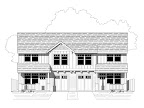We realized that we should have been giving a real world example from the start. In light of that, let's do some quick review using our plan The Belmont #3232. If you recall the equations:
- Afloor x Ufloor x ΔTfloor = Btu/hr floor
- Awall x Uwall x ΔTwall = Btu/hr wall
- Aceil x Uceil x ΔTceil = Btu/hr ceil
- Awindows x Uwindows x ΔTwindows = Btu/hr windows
- Adoor x Udoor x ΔTdoor = Btu/hr door
- Floors: (32x32) x (1/38) x 25°F = 673.68 (1024sf insulated floor, R-38 in joists)
- Walls: (32x18x4 - 339.33) x (1/21*.8) x 45°F = 5262.51 (four walls minus windows, 32'L x 18'H, R-21 with framing factor)
- Ceiling: (32x32) x (1/49*.8) x 25°F = 522.45 (1024sf ceiling, R-49 with framing factor due to edge pinch)
- Windows: 339.33 x 0.30 x 45°F = 4580.96
- Doors: 40 x 0.20 x 45°F = 360
For air infiltration, recall the formula ΔT x ACHnat x Volume x HC = BTU/hr. Our ΔT=45°F, volume is 18432 (32x32x18), HC = 0.022, and we'll assume ACHnat to be based off of a blower door test of 5.0ACH, ergo .25.
- 45°F x .25 x 18432 x 0.022 = 4561.92
Now for the good news! You will have several internal loads that will help to heat your house, that is, they will make this number smaller. The biggest source is the occupants. General convention assumes that there will be 2 people in the master bedroom and one person for each of the other bedrooms. The Belmont is a 4 bedroom home but practically we could assume four occupants living upstairs. Occupants put out anywhere from 200 to 300 btu/hr of heat load. We are preferential towards 275 btu/hr. For four people, this is a reduction of 1100 btu/hr. You can also figure in incandescent lights, the kitchen oven, hair dryers and other such pieces. These don't make a huge difference unless your heat load is so low that you are in PassivHaus range.
Our final result for heating this home in this scenario is 14861.52 btu/hr. Now what? Now we need a heat source. Our first choice might be the typical forced air gas furnace. A quick look at manufacturer catalogs will reveal that 40,000 btu/hr is the smallest one available. Even at a low 90% efficiency this will put out 36,000 btu/hr. But if you have an attached garage, you can always place the furnace there and lose about 40% of your heat bringing the load down to about 25,700 btu/hr. Let's not.
Another option might be electric wall heaters. Each 1kW wall heater = 3412 btu/hr. This calculates to needing 5 heaters. Reviewing this plan shows that there are up to 10 rooms that would need heat. Perhaps several 500W units would be more applicable. Don't forget to install them on an interior wall.
Another choice is a ductless heat pump. You are limited to a max of 4 heads per unit. More heads requires another unit which doubles the price. Or you could get a splitter for some of the heads and share the heat load between rooms. To outfit the Belmont 3232 you would need one head for the dining/parlor, one split head for the office/bath, another for the master and bath, one more for the auxiliary bedrooms. The kitchen, utility room and bathroom would need a 500W electric heat source.
Another option might be radiant heat. In floor hydronic heat puts out 18-25 btu/sf. Assuming 20btu, you could cover 743sf of the floor with tubing. But how do you cover 743sf in a 2000sf house? If you stick to just the walk areas you could make it happen. But unless you are doing an onsite DIY approach, this option can be super expensive.
The final choice would be to increase some insulation in the walls, try for better windows (U-0.025 is reasonable) and tighten the home to 2.0 ACH or less. Resulting calculations reduces to 10519 btu/hr. Then install an HRV in the utility room to cycle fresh air and attach a small heating unit to it.
Any other ideas?
In the very near future we'll refine our simple spreadsheet calculator and make it available for your use. The calculator does most of the math for you but we made this guide available so you'd know what's going on in the background. Happy calculating!






No comments:
Post a Comment